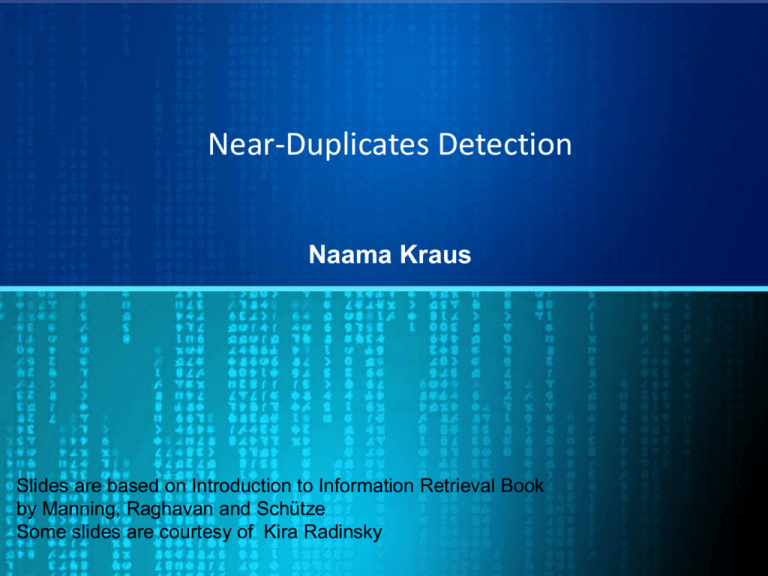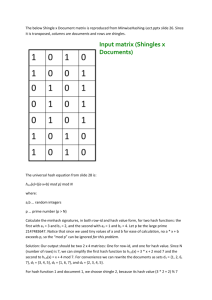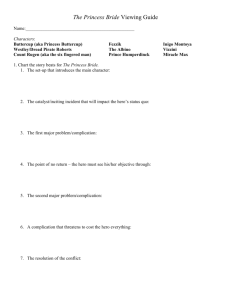tutorial 4 (Near-Duplicates Detection)
advertisement

Near-Duplicates Detection
Naama Kraus
Slides are based on Introduction to Information Retrieval Book
by Manning, Raghavan and Schütze
Some slides are courtesy of Kira Radinsky
Why duplicate detection?
• About 30-40% of the pages on the Web are (near)
duplicates of other pages.
– E.g., mirror sites
• Search engines try to avoid indexing duplicate pages
– Save storage
– Save processing time
– Avoid returning duplicate pages in search results
• Improved user’s search experience
• The goal: detect duplicate pages
Exact-duplicates detection
• A naïve approach – detect exact duplicates
– Map each page to some fingerprint, e.g. 64-bit
– If two web pages have an equal fingerprint
check if content is equal
Near-duplicates
• What about near-duplicates?
– Pages that are almost identical.
– Common on the Web. E.g., only date differs.
– Eliminating near duplicates is desired!
• The challenge
– How to efficiently detect near duplicates?
– Exhaustively comparing all pairs of web pages
wouldn’t scale.
Shingling
• K-shingles of a document d is defined to be the set of all
consecutive sequences of k terms in d
– k is a positive integer
• E.g., 4-shingles of
“My name is Inigo Montoya. You killed my father. Prepare to
die”:
{
}
my name is inigo
name is inigo montoya
is inigo montoya you
inigo montoya you killed
montoya you killed my,
you killed my father
killed my father prepare
my father prepare to
father prepare to die
Computing Similarity
• Intuition: two documents are near-duplicates if their
shingles sets are ‘nearly the same’.
• Measure similarity using Jaccard coefficient
– Degree of overlap between two sets
• Denote by S (d) the set of shingles of document d
• J(S(d1),S(d2)) = |S (d1) S (d2)| / |S (d1) S (d2)|
• If J exceeds a preset threshold (e.g. 0.9) declare
d1,d2 near duplicates.
• Issue: computation is costly and done pairwise
– How can we compute Jaccard efficiently ?
Hashing shingles
• Map each shingle into a hash value integer
– Over a large space, say 64 bits
• H(di) denotes the hash values set derived
from S(di)
• Need to detect pairs whose sets H() have a
large overlap
– How to do this efficiently ? In next slides …
Permuting
• Let p be a random permutation over the hash
values space
• Let P(di) denote the set of permuted hash
values in H(di)
• Let xi be the smallest integer in P(di)
Illustration
Document 1
264
Start with 64-bit H(shingles)
264
Permute on the number line
with p
264
264
Pick the min value
Key Theorem
• Theorem: J(S(di),S(dj)) = P(xi = xj)
– xi, xj of the same permutation
• Intuition: if shingle sets of two documents are
‘nearly the same’ and we randomly permute,
then there is a high probability that the
minimal values are equal.
Proof (1)
• View sets S1,S2 as columns of a matrix A
– one row for each element in the universe.
– aij = 1 indicates presence of item i in set j
•
Example
S1 S2
0
1
1
0
1
0
1
0
1
0
1
1
Jaccard(S1,S2) = 2/5 = 0.4
Proof (2)
• Let p be a random permutation of the rows of
A
• Denote by P(Sj) the column that results from
applying p to the j-th column
• Let xi be the index of the first row in which the
column P(Si) has a 1
P(S1)
P(S2)
0
1
1
0
1
0
1
0
1
0
1
1
Proof (3)
• For columns Si, Sj, four types of rows
A
B
C
D
Si
1
1
0
0
Sj
1
0
1
0
• Let A = # of rows of type A
• Clearly, J(S1,S2) = A/(A+B+C)
Proof (4)
• Previous slide: J(S1,S2) = A/(A+B+C)
• Claim: P(xi=xj) = A/(A+B+C)
• Why ?
– Look down columns Si, Sj until first non-TypeD row
• I.e., look for xi or xj (the smallest or both if they are equal)
– P(xi) = P(xj) type A row
– As we picked a random permutation, the
probability for a type A row is A/(A+B+C)
• P(xi=xj) = J(S1,S2)
Sketches
• Thus – our Jaccard coefficient test is
probabilistic
– Need to estimate P(xi=xj)
• Method:
– Pick k (~200) random row permutations P
– Sketchdi = list of xi values for each permutation
• List is of length k
• Jaccard estimation:
– Fraction of permutations where sketch values
agree
– | Sketchdi Sketchdj | / k
Example
Sketches
R1
R2
R3
R4
R5
S1
1
0
1
1
0
S2
0
1
0
0
1
S3
1
1
0
1
0
S1
Perm 1 = (12345) 1
Perm 2 = (54321) 4
Perm 3 = (34512) 3
S2
2
5
5
S3
1
4
4
Similarities
1-2
0/3
1-3
2/3
2-3
0/3
Algorithm for Clustering Near-Duplicate
Documents
1.Compute the sketch of each document
2.From each sketch, produce a list of <shingle, docID> pairs
3.Group all pairs by shingle value
4.For any shingle that is shared by more than one document, output a
triplet <smaller-docID, larger-docID, 1>for each pair of docIDs sharing
that shingle
5.Sort and aggregate the list of triplets, producing final triplets of the form
<smaller-docID, larger-docID, # common shingles>
6.Join any pair of documents whose number of common shingles exceeds a
chosen threshold using a “Union-Find”algorithm
7.Each resulting connected component of the UF algorithm is a cluster of
near-duplicate documents
Implementation nicely fits the “map-reduce”programming paradigm
Implementation Trick
• Permuting universe even once is prohibitive
• Row Hashing
– Pick P hash functions hk
– Ordering under hk gives random permutation of
rows
• One-pass Implementation
– For each Ci and hk, keep slot for min-hash value
– Initialize all slot(Ci,hk) to infinity
– Scan rows in arbitrary order looking for 1’s
• Suppose row Rj has 1 in column Ci
• For each hk,
– if hk(j) < slot(Ci,hk), then slot(Ci,hk) hk(j)
Example
R1
R2
R3
R4
R5
C1
1
0
1
1
0
C2
0
1
1
0
1
h(x) = x mod 5
g(x) = 2x+1 mod 5
C1 slots
C2 slots
h(1) = 1
g(1) = 3
1
3
-
h(2) = 2
g(2) = 0
1
3
2
0
h(3) = 3
g(3) = 2
1
2
2
0
h(4) = 4
g(4) = 4
1
2
2
0
h(5) = 0
g(5) = 1
1
2
0
0





